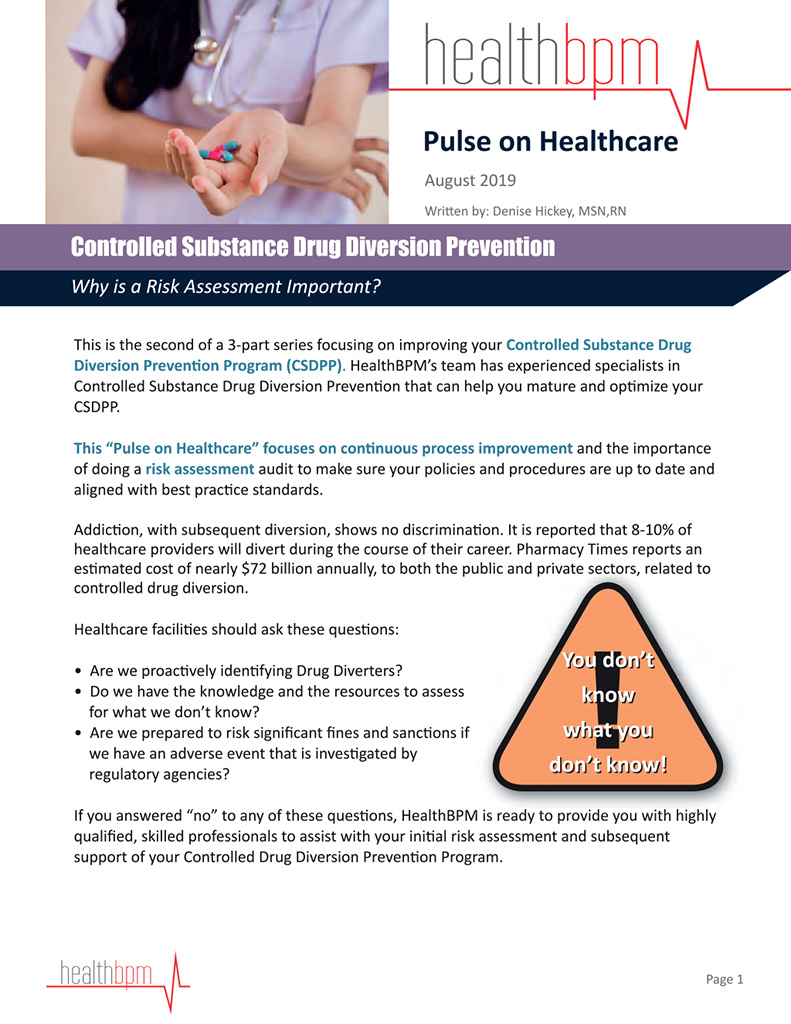
Drug Diversion costs an estimated $72 billion annually. Learn what you can do to make sure your policies and procedures are up to date and aligned with best practice standards.
This is the second of a 3-part series focusing on improving your Controlled Substance Drug Diversion Prevention Program (CSDPP). HealthBPM’s team has experienced specialists in Controlled Substance Drug Diversion Prevention that can help you mature and optimize your CSDPP.
This “Pulse on Healthcare” focuses on continuous process improvement and the importance of doing a risk assessment audit to make sure your policies and procedures are up to date and aligned with best practice standards.
Addiction, with subsequent diversion, shows no discrimination. It is reported that 8-10% of healthcare providers will divert during the course of their career. Pharmacy Times reports an estimated cost of nearly $72 billion annually, to both the public and private sectors, related to controlled drug diversion.
Healthcare facilities should ask these questions:
- Are we proactively identifying Drug Diverters?
- Do we have the knowledge and the resources to assess for what we don’t know?
- Are we prepared to risk significant fines and sanctions if we have an adverse event that is investigated by regulatory agencies?
If you answered “no” to any of these questions, HealthBPM is ready to provide you with highly qualified, skilled professionals to assist with your initial risk assessment and subsequent support of your Controlled Drug Diversion Prevention Program.
We will never completely prevent diversion, although with proper risk assessment, we can certainly implement processes that will deter diversion and lead to early identification of someone who may be diverting.
There is no one single way to identify and prevent diversion. It is imperative that a multidisciplinary approach be employed to create a program that meets the goals of determent and early identification. (Statistics show that early identification and treatment for those suffering from addiction will improve chances of a successful recovery.)
The journey to discovering what you don’t know begins with a detailed Gap Analysis of your current processes and workflows.
A complete Gap Analysis is crucial for the development of a continuous process improvement program in the fast paced, ever changing world of healthcare. Process improvement is not a one-time event. It is imperative that institutions remain up to date with the most recent best practice standards to ensure high quality patient safety and regulatory compliance. Priorities will change based upon new evidence shared within the diversion community and it is the responsibility of every institution to re-evaluate on a regular basis.
Once priorities for process improvement have been identified, the PLAN-DO-STUDY-ACT (PDSA) model can be used for implementing change.
- PLAN – engage staff, objective, questions, predictions;
- DO – implement the plan on a small scale, document observations of what went well, challenges that occurred (expected and unexpected), begin to formulate data analysis;
- STUDY – complete formulation of data, compare data to questions/predictions, document lessons learned;
- ACT – decide what changes are to be made, then repeat the cycle on a larger scale.
Evidence shows that when change is implemented in small, methodical steps it will lead to greater regulatory compliance and a healthy work environment. Regulatory compliance and a healthy work environment are factors that will ensure patient safety.
HealthBPM offers advisory consulting services to help you improve your Controlled Substance Drug Diversion Prevention Program by focusing on these three critical areas:
- Enhancing Educational Tools and Communication
- Aligning Best Practice Policy and Procedures
- Optimizing Systems
Mitigate your risk of narcotic theft with HealthBPM.
Controlled substance management and monitoring is critical for care systems. We at HealthBPM are here to help—let’s talk about how we can partner with you to improve your Drug Diversion Prevention Program.
Уход за ожогами
Pulse on Healthcare: Assessing Risk for Drug Diversion | HealthBPM